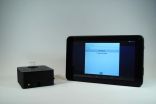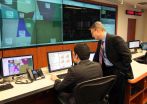(Press-News.org) Why some planets, like Saturn or Jupiter, have their rings, while others like, the Earth or Mars do not? It turned out that "the size does not matter" -- not only giants as Saturn possess the rings, but even tiny asteroids do: According to the recent discovery of the Spitzer Space Telescope, the remote asteroid Chariklo, which is only 260 km in diameter, also has rings.
A natural answer may be the following: Occasionally, in a far past, some planets had much more material in their vicinity then the other ones. The material was in a form of dust. Dust particles merged together, due to gravitational or adhesive forces, and larger and larger aggregates appeared in a system. This seems to be clear, but what had happened to the particles, when they ceased to grow, reaching a size of a house? What was a mechanism that hindered their further growth? It remained enigmatic. Moreover, the particle size distribution followed, with a high accuracy, a beautiful mathematical law of "inverse cubes". This law, for instance, implies, that the abundance of particles of size 2 meters is 8 time less than that of particles of size 1 meter; the abundance of particles of size 3 meter is respectively 27 times less, and so on. The nature of this law was also a riddle.
An international team of scientists managed to resolve the above riddles of the particle size distribution in Saturn's rings. The team had four Russians on board: a graduate of the M.V. Lomonosov Moscow State University Nikolai Brilliantov - presently professor at the University of Leicester in the UK, Pavel Krapivsky - presently professor at the Boston University in the USA, Anna Bodrova from the Chair of Polymer and Crystal Physics of the Faculty of Physics of the M.V. Lomonosov Moscow State Unversity and Vladimir Stadnichuk, from the same Chair of Polymer and Crystal Physics. The researches have shown that the observed size distribution is universal and expected to be the same for all planetary rings, provided the rings' particles have a similar nature. Furthermore, the scientists managed to unravel the mystery of the "inverse cubes" law. The according article co-authored by professors Frank Spahn from the University of Potsdam, Germany, Jürgen Schmidt from the University of Oulu, Finland and Hisao Hayakawa from the Kyoto University, Japan, has been published in the journal Proceedings of the National Academy of Sciences.
The magnificent Saturn Rings stretch by hundred of thousand kilometers outward from Saturn. In the other, perpendicular direction they are incredibly thin -- only a few tens of meters, which makes the Saturn rings the most sharp object in nature, million times "sharper" than the sharpest razor. The rings consist of ice particle with a tiny addition of rocky material and orbit the planet with an enormous speed of 72,000 kilometers per hour. But this is an average or orbital speed, while the individual velocities have slightly different values. Commonly deviations from the orbital speed are extremely small, only a few meters per hour! When rings' particles collide with such low velocities, they merge, since the attractive surface forces keep them together. As a result a joint aggregate is formed, similar to what happens if two snowballs are squeezed together. In this way the rings' particles permanently merge. There exist, however, an opposite process: A very small fraction of particles has a significant deviation of their velocity from the average one. When such "fast" particles collide with the neighbors, both particles crumble into small pieces. This occurs very seldom but nevertheless leads to a steady balance between aggregation and fragmentation.
Scientists have constructed a mathematical model of the above processes in rings and studied this model by various methods. In particular, they solved numerically a vast system of differential equations. This could be efficiently done only with a use of a powerful supercomputer. This part of the work has been carried out by the Moscow part of the team, who exploited "Chebyshev" -- the supercomputer of the M.V. Lomonosov Moscow State University. "Chebyshev", named in honor of a famous Russian mathematician, is one of the most powerful computers in Europe.
The researchers have solved the riddle of the "inverse cubes" law; they also explained why the abundance of particles, larger than certain size, dramatically drops down. Moreover, an important conclusion followed from their model: The particles' size distribution in planetary rings is universal. That is, it would follow the same laws provided the nature of the rings' particles is the same as that of the Saturn rings. According to the researchers, in particular, as Anna Bodrova from the Moscow State University explained, this universality is yet a well-grounded hypothesis. In order to confirm or to refute it, a thorough investigation of other rings is needed.
The results of the study entail a number of other scientific conclusions, for example, concerning the mechanism of rings formation and evolution. The results show that the rings of Saturn are in a steady-state. Furthermore, since the characteristic time of the rings' respond to any external perturbation does not exceed 10 000 years, nothing catastrophic has happened to the rings since the Bronze Age.
According to the Nobel Prize winner in Physics and Fellows of the Royal Society, Pyotr Kapitsa:
"There's nothing more practical than a good theory". This statement, also attributed to a German-American psychologist Kurt Lewin, is totally relevant for the above research: The scientists have developed a rather universal mathematical tool, which could be straightforwardly applied to a variety of systems in nature and industry. Whenever a system is comprised of particles that can merge colliding at low velocities and break into small pieces colliding at large velocities, the size distribution of particles will demonstrate the amazing "inverse cubes" law.
INFORMATION:
UC Davis study should help guide patients and their oncologists
(SACRAMENTO, Calif.) -- Combing data collected on thousands of California ovarian cancer patients, UC Davis researchers have determined that almost one-third survived at least 10 years after diagnosis.
The unprecedented findings upend the notion that women diagnosed with cancer of the ovary always face a poor chance of survival. In fact, while the study confirmed earlier findings on characteristics associated with ovarian cancer survival -- younger age, earlier stage and lower grade tumors at diagnosis ...
The dull black plastic of the device on Joshua Pearce's desk belies its usefulness. Pearce picks up the box, which has a switch on the side and a small opening on top. A handful of vials sit in a bag nearby, and each would fit snugly in the opening. The set-up seems generic, even bland, except that it could radically change how we deal with water quality issues.
Pearce, who has a joint appointment as an associate professor of materials science and engineering as well as electrical and computer engineering, runs an open sustainability technology lab at Michigan Technological ...
COLLEGE STATION - Woody plant encroachment is one of the biggest challenges facing rangelands worldwide, but it consistently has been under-measured and poorly understood, said a Texas A&M AgriLife Research scientist in College Station.
Dr. Matthew Berg, an AgriLife Research postdoctoral research associate in the Texas A&M department of ecosystem and science management, is trying to change both the understanding and measurement with his latest study, which was captured in the July issue of the Rangeland Ecology and Management publication, http://bit.ly/1JK8JhU.
Berg ...
Accurately forecasting future electricity needs is tricky, with sudden weather changes and other variables impacting projections minute by minute. Errors can have grave repercussions, from blackouts to high market costs. Now, a new forecasting tool that delivers up to a 50-percent increase in accuracy and the potential to save millions in wasted energy costs has been developed by researchers at the Department of Energy's Pacific Northwest National Laboratory.
Performance of the tool, called the Power Model Integrator, was tested against five commonly used forecasting ...
Fundamental differences between how the brain forms during adolescence have been discovered in children with schizophrenia and their siblings, a new study shows.
The study opens up new avenues for researchers to explore when developing treatment for the illness, which can be hugely debilitating for children.
Researchers from the University of Melbourne and the National Institute of Mental Health in Washington DC used structural brain magnetic resonance imaging (MRI) to map the brains of 109 children with childhood-onset schizophrenia (COS), from ages 12 to 24.
They ...
The DZD-researchers at Helmholtz Zentrum München and German Diabetes Center Düsseldorf analyzed more than 1.800 blood samples of participants, who joined the German large-scale study KORA*. Using a comprehensive approach, the scientists investigated metabolic products (metabolites) as well as genetics of these participants. They found that the administration of Metformin** in patients suffering from Type 2 Diabetes led to a change in metabolite levels. According to the authors, this was associated with a significantly decreased level of LDL cholesterol***, which ...
First the scaffold is cracked, then defective parts are removed: Cells repair damaged DNA by a different mechanism than so far assumed, as chemists from Ludwig-Maximilians-Universitaet (LMU) in Munich have shown.
Defects in DNA can cause serious harm to an organism, including cell death or the development of cancer. Efficient repair mechanisms are therefore of vital importance. LMU chemist Professor Christian Ochsenfeld, Chair of Theoretical Chemistry at LMU, and Dr. Keyarash Sadeghian from his group have explained for the first time in detail how a human DNA repair ...
ARLINGTON HEIGHTS, Ill. (August 6, 2015) - There are times when emergency physicians can't be 100 percent sure a person is suffering from a severe allergic reaction, known as anaphylaxis, and may hesitate to use epinephrine. A new article says when in doubt - administer the epinephrine.
An article in the Annals of Allergy, Asthma and Immunology, the scientific publication of the American College of Allergy, Asthma and Immunology (ACAAI), highlights recommendations from a panel discussion among allergists and emergency physicians. The panel of experts examined barriers ...
Scientists at the University of Newcastle, UK, have used a combination of small molecules to turn cells isolated from human skin into Schwann cells - the specialised cells that support nerves and play a role in nerve repair. This new method generates large and pure populations of Schwann cells and hence is a promising step forward for the repair of peripheral nerve injuries. This research has just been published in the scientific journal Development at http://dev.biologists.org/
Currently, nerve repair strategies involve taking grafts from patients and using these to ...
TORONTO, August 5 2015 -- The term "self-regulation" has started appearing in children's report cards of late, but what it means is often unclear to parents. Thanks to three York University researchers, who have created a clear-cut definition for learning this important psychological concept, parents and teachers can now have a better understanding of what "self-regulation" means and how they can help their children develop that capacity.
"My hope is that every parent whose child has had a meltdown in a mall, and every teacher who has to work hard every day to prevent ...


